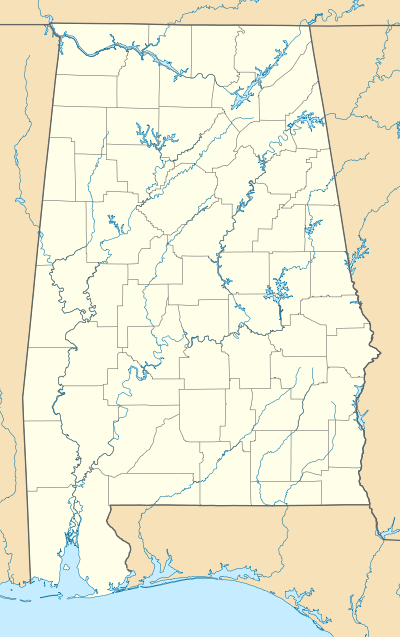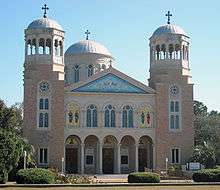Malbis, Alabama
Malbis is an Unincorporated community in Baldwin County, Alabama, United States. The community lies at the crossroads of U.S. 90 and Alabama State Route 181 just south and north of I-10. Portions of the settlement are today within the city limits of Daphne. The incorporated city of Loxley lies to the east, and Spanish Fort to the north.
Malbis, Alabama | |
|---|---|
 Malbis, Alabama Location within the state of Alabama  Malbis, Alabama Malbis, Alabama (the United States) | |
| Coordinates: 30°39′21″N 87°51′07″W | |
| Country | United States |
| State | Alabama |
| County | Baldwin |
| Elevation | 197 ft (60 m) |
| Time zone | UTC-6 (Central (CST)) |
| • Summer (DST) | UTC-5 (CDT) |
| ZIP code | 36526 |
| Area code(s) | 251 |
| GNIS feature ID | 0156648 |
| Website | |
Malbis Plantation | |
 | |
| Location | 10145 US 90 |
| Nearest city | Daphne, Alabama |
| NRHP reference No. | 11000238[1] |
| Added to NRHP | May 10, 2011 |
Malbis is considered a community or populated place but is not identified in the United States Census. It is part of the Daphne–Fairhope–Foley Micropolitan Statistical Area.
The Malbis Plantation was inducted into the National Register of Historic Places in May 2011.
History

Known originally as the Malbis Plantation, the settlement was founded in 1906 by Jason Malbis. Malbis was a Greek philanthropist born in Doumena, Greece as Antonius Markopoulos. Malbis had been an Orthodox monk[2] before coming to the United States to investigate the condition of fellow Greeks who had immigrated to the US.[3] He changed his name to Jason Malbis and migrated south to Alabama.
While traveling through Alabama, Malbis became enamored with Baldwin County and purchased the land that would become the Greek colony.[4] The community was populated for many years mostly by those of either secular or religious Greek heritage.[5] The Malbis Memorial Church, a Greek Orthodox church, was built by the settlers and still stands today.
The community once included the Malbis Bakery, an ice plant, plant nursery, cannery, hotels, restaurants, its own power plant, turpentine, dairy, lumber, water towers and many acres of farmland. During the peak of the colony's success, the economy was largely based upon providing table food to nearby Mobile, Alabama.[4] Much of the land was sold for commercial development, including a 500-acre (2.0 km2) soybean field, which is currently covered by a large retail shopping mall.[6][7]
References
- "Weekly List of Actions Taken on Properties: 5/09/11 through 5/13/11". National Park Service. March 16, 2012. Retrieved 16 March 2012.
- Roy Hoffman (March 13, 2010). "The Jewel of Malbis". Mobile Register. Mobile, Alabama. p. 1D.
- Scott, Florence; Scott, Richard (1965). "Daphne". Mobile, Alabama: Jordan Publishing Company: 175. Cite journal requires
|journal=(help) - Burnett, Jr., O. Lawrence (2006). "Coastal Kingdom". Baltimore: PUBLISHAMERICA, LLLP: 285. Cite journal requires
|journal=(help) - Henderson, Russ (11 September 2008). "Malbis plantation 'matriarch' Bessie Papas dies at 98". Press-Register. Retrieved 31 March 2012.
- Henderson, Russ (2008-09-12). "The last of Malbis' original settlers dies". Press Register (Mobile, Alabama). Press Register. Archived from the original on 2011-06-09. Retrieved 2008-11-21.
- Henderson, Russ (May 31, 2008). "Malbis family mourns". Press Register. Mobile, Alabama.
| Wikimedia Commons has media related to Malbis Plantation. |
